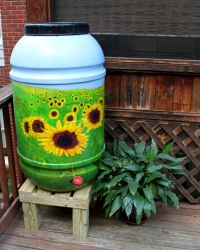The Rain Barrel: Some Things Old, Become New Again

Atlanta, GA, August 07, 2014 --(PR.com)-- As Americans are becoming more conscious of water use, along with the spread of droughts across the United States, rain barrels are becoming an essential part of the residential landscape. But where do rain barrels come from?
Collecting and storing rainwater to use for later use has been in practice for over 2,000 years. History shows that ancient civilizations used forms of open cisterns carved in the ground to save water for a later time.
The use of rain barrels in this country was actually a bi-product of shipping dry goods in wooden barrels across the United States in the 1800’s. When goods were unpacked and barrels could no longer be used, the barrels were placed under roof eves to capture the rain.
As rain water was void of chemicals and closer to the house than the well, it was often used for washing clothes and heated for Saturday night baths. As a matter of fact, even today we meet people at our workshops that talk about their grandparents washing their hair and clothes from rain barrel water.
After World War II, the use of wooden barrels began to cease with the manufacturing of plastic. With the expansion of public water utilities, the use of wells, buckets, and rain barrels declined due to more efficient ways to provide homes with water.
In the 1990’s with landfill space becoming limited and more expensive, the recycling age began in the United States. People began to realize that plastic drums took up large amounts of landfill space. During this same time, storm water was identified as the number one water polluter of streams, rivers and lakes. Communities in the New England area began taking plastic barrels and converting them into rain barrels. Many of these rain barrels in their prior life were used to import olives and peppers from the Mediterranean.
Americans have enjoyed an abundance of water that is not only inexpensive, but consistently the highest in quality worldwide. Since 2000, Americans have begun to realize that water is a finite source. Droughts and water shortages across our country made people understand that rainwater harvesting; a practice that was used in Europe and a no brainer in Australia could be used in this country as well. The practice began taking off in California, Texas, and North Carolina during this time. Here in Atlanta people began to change their water usage practices with the drought in 2007 and started looking at rainwater harvesting and rain barrels.
By installing a rain barrel that is either made in a factory or at a rain barrel work shop, the simple rain barrel is the easiest and least expensive way to collect and save water.
The 2000’s have ushered in the era of sustainable revolution including backyard and urban gardening, living off the grid, wholesale composting operations, and commercial and residential solar power along with solar powered cars.
The Rain Barrel Depot has joined this growing sustainability movement by providing an affordable way for people to participate in water conservation.
Collecting and storing rainwater to use for later use has been in practice for over 2,000 years. History shows that ancient civilizations used forms of open cisterns carved in the ground to save water for a later time.
The use of rain barrels in this country was actually a bi-product of shipping dry goods in wooden barrels across the United States in the 1800’s. When goods were unpacked and barrels could no longer be used, the barrels were placed under roof eves to capture the rain.
As rain water was void of chemicals and closer to the house than the well, it was often used for washing clothes and heated for Saturday night baths. As a matter of fact, even today we meet people at our workshops that talk about their grandparents washing their hair and clothes from rain barrel water.
After World War II, the use of wooden barrels began to cease with the manufacturing of plastic. With the expansion of public water utilities, the use of wells, buckets, and rain barrels declined due to more efficient ways to provide homes with water.
In the 1990’s with landfill space becoming limited and more expensive, the recycling age began in the United States. People began to realize that plastic drums took up large amounts of landfill space. During this same time, storm water was identified as the number one water polluter of streams, rivers and lakes. Communities in the New England area began taking plastic barrels and converting them into rain barrels. Many of these rain barrels in their prior life were used to import olives and peppers from the Mediterranean.
Americans have enjoyed an abundance of water that is not only inexpensive, but consistently the highest in quality worldwide. Since 2000, Americans have begun to realize that water is a finite source. Droughts and water shortages across our country made people understand that rainwater harvesting; a practice that was used in Europe and a no brainer in Australia could be used in this country as well. The practice began taking off in California, Texas, and North Carolina during this time. Here in Atlanta people began to change their water usage practices with the drought in 2007 and started looking at rainwater harvesting and rain barrels.
By installing a rain barrel that is either made in a factory or at a rain barrel work shop, the simple rain barrel is the easiest and least expensive way to collect and save water.
The 2000’s have ushered in the era of sustainable revolution including backyard and urban gardening, living off the grid, wholesale composting operations, and commercial and residential solar power along with solar powered cars.
The Rain Barrel Depot has joined this growing sustainability movement by providing an affordable way for people to participate in water conservation.
Contact
The Rain Barrel Depot
Gene Kelly
404-829-2647
www.therainbarreldepot.com
Gene Kelly
404-829-2647
www.therainbarreldepot.com
Categories
